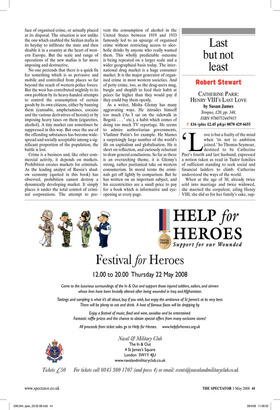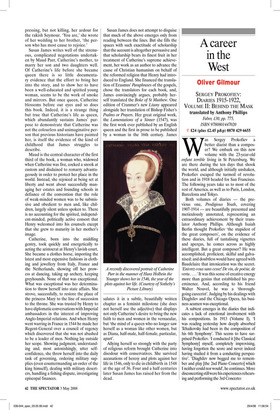Last but not least
Robert Stewart
CATHERINE PARR: HENRY VIII’S LAST LOVE by Susan James Tempus, £20, pp. 348, ISBN 9780752445915 ✆ £16 (plus £2.45 p&p) 0870 429 6655 ‘Love is but a frailty of the mind when ’tis not to ambition joined.’ So Thomas Seymour, destined to be Catherine Parr’s fourth and last husband, expressed a notion taken as read in Tudor families of sufficient standing to seek social and financial ladders to climb. Catherine understood the ways of the world.
When at the age of 30, already twice sold into marriage and twice widowed, she married the corpulent, ailing Henry VIII, she did so for her family’s sake, sup pressing, but not killing, her ardour for the rakish Seymour. ‘You are,’ she wrote of her wedding to her brother, ‘the person who has most cause to rejoice.’ Susan James writes well of the strenuous, complicated negotations undertaken by Maud Parr, Catherine’s mother, to marry her son and two daughters well. Of Catherine’s life before she became queen there is so little documentary evidence that the effort to bring her into the story, and to show her to have been a well-educated and spirited young woman, seems to be the work of smoke and mirrors. But once queen, Catherine blossoms before our eyes and so does this book. Indeed, it is a strange thing but true that Catherine’s life as queen, which abundantly sustains James’ purpose to demonstrate that Catherine was not the colourless and unimaginative person that previous historians have painted her, is itself the evidence of the kind of childhood that James struggles to describe.
Maud is the central character of the first third of the book, a woman who, widowed when Catherine was five, cocked a snook at custom and disdained to remarry advantageously in order to protect her place in the world. Instead, she rejoiced at being set at liberty and went about successfully managing her estates and founding schools in defiance of the convention that the role of weak-minded women was to be submissive and obedient to men and, like children, largely silent unless spoken to. There is no accounting for the spirited, independent-minded, politically active consort that Henry welcomed into his counsels except that she grew to maturity in her mother’s image.
Catherine, born into the middling gentry, took quickly and energetically to acting the aristocrat at Henry’s lavish court. She became a clothes horse, importing the latest and most expensive fashions in clothing and jewellery from Italy, France and the Netherlands, showing off her prowess at dancing, taking up archery, keeping greyhounds. None of that was exceptional. What was exceptional was her determination to throw herself into state affairs. She strove, successfully, to restore the place of the princess Mary to the line of succession to the throne. She was trusted by Henry to have diplomatic conversations with Imperial ambassadors in the interest of improving Anglo-Imperial relations. And when Henry went warring in France in 1544 he made her Regent-General over a council of regency which discovered that she was not abashed to be a leader of men. Nothing lay outside her scope. Showing judgment, understanding and, most astonishingly, utter selfconfidence, she threw herself into the daily task of governing, ordering military supplies (even countermanding an order of the king himself), dealing with military deserters, handling a fishing dispute, investigating episcopal finances. Susan James does not attempt to disguise that much of the above emerges only from reading between the lines. But she fills the spaces with such exactitude of scholarship that the account is altogether persuasive and that scholarship bears its finest fruit in her treatment of Catherine’s supreme achievement, her work as an author to advance the cause of Christian humanism on behalf of the reformed religion that Henry had introduced to England. She financed the translation of Erasmus’ Paraphrases of the gospels, chose the translators for each book, and, James convincingly argues, probably herself translated the Boke of St Matthew. One edition of Cranmer’s new Litany appeared alongside her translation of Bishop Fisher’s Psalms or Prayers. Her great original work, the Lamentations of a Sinner (1547), was the first work ever published by an English queen and the first in prose to be published by a woman in the 16th century. James salutes it in a subtle, beautifully written chapter as a feminist milestone (she does not herself use the adjective) that displays not only Catherine’s desire to bring the new faith to men and women in the vernacular, but ‘the mind of a queen who no longer saw herself as a woman like other women, but as Diana, half-male, half-female, particular, apart’.
Allying herself so strongly with the party of religious reform brought Catherine into disodour with conservatives. She survived accusations of heresy and plots against her life in 1546, only to die in childbirth in 1548 at the age of 36. Four and a half centuries later Susan James has raised her from the dead.



















































































 Previous page
Previous page